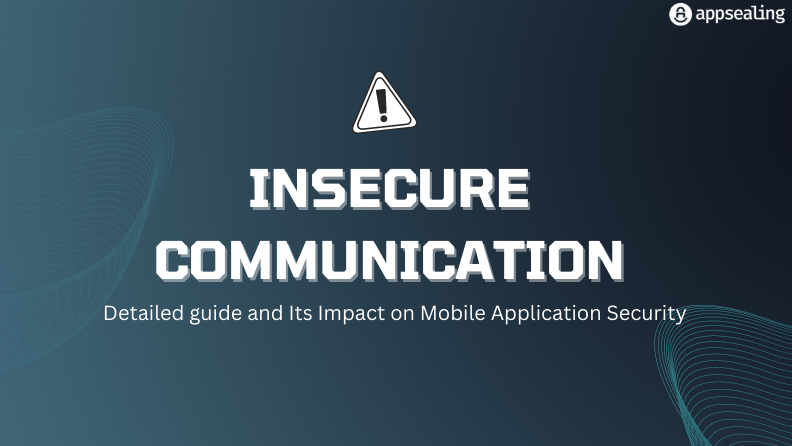The Impact of Insecure Communication in Mobile Applications
or
Insecure Communication in Mobile Applications and Its Impact on Overall Security
Let us start with two fascinating figures; 6.64 Billion and $1.7 trillion.
The first figure details the number of smartphone users worldwide as of 2022, while the second is the overall volume of financial transactions that took place via mobile in 2021.
Smartphone security becomes all the more important when so much is at stake.
That is because smartphones are now an integral part of our lives, and the more apps we use, the deeper the access they have to our most sensitive information. Such sensitive data is only possible if steps are taken to ensure secure communication while developing mobile applications.
Ready to protect your app?
Start 30-days FREE TRIAL. No credit card required. Deliver Secure Mobile Apps Faster in minutes with the leader in application security.

Insecure Communication
Simply put, Insecure communication refers to communication that takes place between a client and server or between servers over insecure channels. If the communication involves the transmission of unencrypted data, then the communication channel is left vulnerable to man-in-the-middle attacks (MITM).
A MITM attack has two distinct phases:
- Interception: In the interception phase, the attacker intercepts traffic before it reaches its intended destination. They can then either use IP Spoofing, ARP Spoofing or DNS Spoofing.
- Decryption: Once the data stream has been intercepted, the decryption phase begins. The goal of this phase is to decrypt the traffic without raising any red flags. The attacker can then use several methods, such as HTTPS Spoofing, SSL Beast, SSL Hijacking, and SSL stripping.
How Does It Happen?
Insecure communication is a significant security vulnerability in mobile applications and has been rated the third most exploited risk by the OWASP Mobile Top 10 List.
If data can be intercepted or changed without detection, we know an application is vulnerable to insecure communication. There are plenty of eavesdropping tools available in the market that can highlight any applications that are transmitting data as cleartext. Insecure transmission is not only caused by how the data is transmitted.
A mobile application can be either a Native app, a Hybrid, or a Web-based one. The type of app dictates which channels Mobile App Communication will take place over.
These channels include TCP/IP, WiFi, Bluetooth, NFC, 4G/5G networks, etc. Each with its own set of vulnerabilities.
Examples of Insecure Communication
Take this scenario, for example, to establish a secure channel, the mobile app, and an endpoint successfully connect and perform a TLS handshake. However, the mobile app does not inspect the certificate provided by the server and accepts any certification provided by the server unconditionally.
This disables mutual authentication between the mobile app and the endpoint. Through a TLS proxy, the mobile app is vulnerable to man-in-the-middle attacks. Such lapses in design lead to some serious security vulnerabilities.
A report by Positive Technologies has discovered that over 35% of all mobile application devices are vulnerable due to insecure communication of sensitive user data.
Insecure communication: Risks and Impact
Insecure mobile app communication can be disastrous on multiple levels. As a business, you can suffer irreversible reputational damage if your mobile application is the primary means of violating a user’s privacy.
A security breach can lead to Identity Theft or Fraud.
One of the most significant mobile data breaches occurred with Apple in 2021. Private photos, personal chats, sensitive data, and the locations of over 900 million active users were compromised.
Take this scenario; you have an admin account, and your mobile application deals with sensitive data. If this account were to be intercepted, the attacker would now have access to the entire application and, thus, access to all sensitive user data. It is crucial to have safeguards that are tested thoroughly during the application development phase to ensure something like this never happens.
How Can I Protect Myself Against Insecure Communication?
You, as a mobile app developer, should incorporate a few best practices into your development cycle. Let’s take a look at a few of them:
- Always work with the assumption that your network layer is insecure
- Always account for third-party entities such as analytics companies or social networks
- Always use industry-standard cipher suites
- Any transmission of sensitive data, whether to the backend API, web services, and so on, should be done only after applying SSL or TLS to the transport channels
- Remember, SSL certificates can be forged. Only use those signed by a trusted CA provider
- Consistently enforce SSL Chain Verification
- Self-Signed certificates are a big no
- If an invalid certificate is detected, make sure the user is alerted
- Don’t take chances with sensitive data. Add a secondary layer of encryption before you hand off the sensitive data to the SSL channel. This will act as a second line of defence
- Ensure you never send sensitive data over open channels such as SMS, MMS, or push notifications
Summing It Up
Whether you are creating a brand new app or updating it to ensure it is secure and safe, cross-platform communication should be noticed. Always use encrypted data transmission methods over the air (OTA) and when storing secure data on the device.
Never assume your users will use your app as intended, and incorporate mechanisms to detect tampering. These are a few best practices for secure inter-application communication that can help prevent your users from being vulnerable to attacks against vulnerabilities in the way you transmit information between apps on their mobile devices.
How AppSealing Helps?
To get the best results with Android and iOS mobile applications, AppSealing assists developers who need to focus on a few key areas like minimal application permissions, proper information guarding mechanism and well-implemented data encryption etc.
If you’re looking for a way to secure your applications without any additional coding, AppSealing is the perfect solution.
Learn more and sign up for a free trial. With AppSealing, you can rest assured that your applications are safe from any potential insecure communication threats.
Ready to protect your app?
Start 30-days FREE TRIAL. No credit card required. Deliver Secure Mobile Apps Faster in minutes with the leader in application security.







